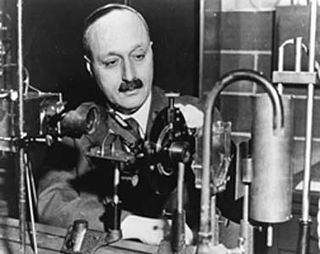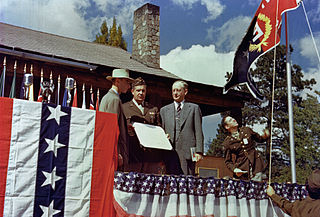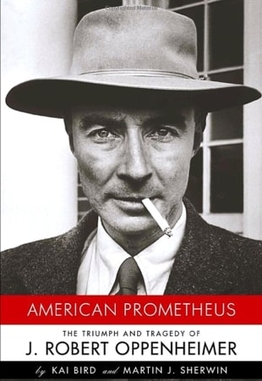
"Fat Man" was the codename for the type of nuclear weapon the United States detonated over the Japanese city of Nagasaki on 9 August 1945. It was the second of the only two nuclear weapons ever used in warfare, the first being Little Boy, and its detonation marked the third nuclear explosion in history. The first one was built by scientists and engineers at Los Alamos Laboratory using plutonium manufactured at the Hanford Site and was dropped from the Boeing B-29 Superfortress Bockscar piloted by Major Charles Sweeney.

The Manhattan Project was a research and development program undertaken during World War II to produce the first nuclear weapons. It was led by the United States in collaboration with the United Kingdom and Canada. From 1942 to 1946, the project was directed by Major General Leslie Groves of the U.S. Army Corps of Engineers. Nuclear physicist J. Robert Oppenheimer was the director of the Los Alamos Laboratory that designed the bombs. The Army program was designated the Manhattan District, as its first headquarters were in Manhattan; the name gradually superseded the official codename, Development of Substitute Materials, for the entire project. The project absorbed its earlier British counterpart, Tube Alloys, and subsumed the program from the American civilian Office of Scientific Research and Development. The Manhattan Project employed nearly 130,000 people at its peak and cost nearly US$2 billion, over 80 percent of which was for building and operating the plants that produced the fissile material. Research and production took place at more than 30 sites across the US, the UK, and Canada.

Edward Teller was a Hungarian-American theoretical physicist and chemical engineer who is known colloquially as "the father of the hydrogen bomb" and one of the creators of the Teller–Ulam design.

J. Robert Oppenheimer was an American theoretical physicist who served as the director of the Manhattan Project's Los Alamos Laboratory during World War II. He is often called the "father of the atomic bomb" for his role in overseeing the development of the first nuclear weapons.

Fat Man and Little Boy is a 1989 American epic historical war drama film directed by Roland Joffé, who co-wrote the script with Bruce Robinson. The story follows the Manhattan Project, the secret Allied endeavor to develop the first nuclear weapons during World War II. The film is named after "Little Boy" and "Fat Man", the two bombs dropped on the Japanese cities of Hiroshima and Nagasaki, respectively. The film starred Paul Newman as Leslie Groves and Dwight Schultz as J. Robert Oppenheimer, with supporting roles filled by Bonnie Bedelia, John Cusack, Laura Dern, John C. McGinley and Natasha Richardson.

The Franck Report of June 1945 was a document signed by several prominent nuclear physicists recommending that the United States not use the atomic bomb as a weapon to prompt the surrender of Japan in World War II.

The Manhattan Project was a research and development project that produced the first atomic bombs during World War II. It was led by the United States with the support of the United Kingdom and Canada. From 1942 to 1946, the project was under the direction of Major General Leslie Groves of the US Army Corps of Engineers. The Army component of the project was designated the Manhattan District; "Manhattan" gradually became the codename for the entire project. Along the way, the project absorbed its earlier British counterpart, Tube Alloys. The Manhattan Project began modestly in 1939, but grew to employ more than 130,000 people and cost nearly US$2 billion. Over 90% of the cost was for building factories and producing the fissionable materials, with less than 10% for development and production of the weapons.

The Einstein–Szilard letter was a letter written by Leo Szilard and signed by Albert Einstein on August 2, 1939, that was sent to President of the United States Franklin D. Roosevelt. Written by Szilard in consultation with fellow Hungarian physicists Edward Teller and Eugene Wigner, the letter warned that Germany might develop atomic bombs and suggested that the United States should start its own nuclear program. It prompted action by Roosevelt, which eventually resulted in the Manhattan Project, the development of the first atomic bombs, and the use of these bombs on the cities of Hiroshima and Nagasaki.

The Szilárd petition, drafted and circulated in July 1945 by scientist Leo Szilard, was signed by 70 scientists working on the Manhattan Project in Oak Ridge, Tennessee, and the Metallurgical Laboratory in Chicago, Illinois. It asked President Harry S. Truman to inform Japan of the terms of surrender demanded by the allies, and allow Japan to either accept or refuse these terms, before America used atomic weapons. However, the petition never made it through the chain of command to President Truman. It was not declassified and made public until 1961.

Hiroshima is a 1995 Japanese-Canadian war drama film directed by Koreyoshi Kurahara and Roger Spottiswoode about the decision-making processes that led to the dropping of the atomic bombs by the United States on the Japanese cities of Hiroshima and Nagasaki toward the end of World War II. The three-hour film was made for television and had no theatrical release.

The Making of the Atomic Bomb is a history book written by the American journalist and historian Richard Rhodes, first published by Simon & Schuster in 1987. The book won multiple awards, including Pulitzer Prize for General Non-Fiction. The narrative covers people and events from early 20th century discoveries leading to the science of nuclear fission, through the Manhattan Project and the atomic bombings of Hiroshima and Nagasaki.

The Beginning or the End is a 1947 American docudrama film about the development of the atomic bomb in World War II, directed by Norman Taurog, starring Brian Donlevy, Robert Walker, and Tom Drake, and released by Metro-Goldwyn-Mayer. The film dramatizes the creation of the atomic bomb in the Manhattan Project and the bombing of Hiroshima.

Day One is a made-for-TV docudrama film about The Manhattan Project, the research and development of the atomic bomb during World War II. It is based on the book by Peter Wyden. The film was written by David W. Rintels and directed by Joseph Sargent. It starred Brian Dennehy as General Leslie Groves, David Strathairn as Dr. J. Robert Oppenheimer and Michael Tucker as Dr. Leo Szilard. It premiered in the United States on March 5, 1989 on the CBS network. It won the 1989 Emmy award for Outstanding Drama/Comedy Special. The movie received critical acclaim for its historical accuracy despite being a drama.

Substantial debate exists over the ethical, legal, and military aspects of the atomic bombings of Hiroshima and Nagasaki on 6 August and 9 August 1945 respectively at the close of World War II (1939–45).

Calculating God is a 2000 science fiction novel by Canadian writer Robert J. Sawyer. It takes place in the present day and describes the arrival on Earth of sentient aliens. The bulk of the novel covers the many discussions and arguments on this topic, as well as about the nature of belief, religion, and science. Several planetary civilizations illustrate the logical conclusion of the Fermi paradox.

American Prometheus: The Triumph and Tragedy of J. Robert Oppenheimer is a 2005 biography of theoretical physicist J. Robert Oppenheimer, the leader of the Manhattan Project which produced the first nuclear weapons, written by Kai Bird and Martin J. Sherwin over a period of 25 years. It won numerous awards, including the 2006 Pulitzer Prize for Biography or Autobiography.

Trinity: A Graphic History of the First Atomic Bomb is the debut graphic novel written and illustrated by Jonathan Fetter-Vorm. It provides an account of the Manhattan Project and the atomic bombings of Hiroshima and Nagasaki, as well as mentioning the chain of events after. The title arises from the code-name, Trinity, given to the test site for the first nuclear weapon.
James William Kunetka is an American writer best known for his science fiction novels Warday and Nature's End. He has also written non-fiction on the topic of the atomic age.

The Bomb is a 2015 American documentary film about the history of nuclear weapons, from theoretical scientific considerations at the very beginning, to their first use on August 6, 1945, to their global political implications in the present day. The film was written and directed by Rushmore DeNooyer for PBS. The project took a year and a half to complete, since much of the film footage and images were only recently declassified by the United States Department of Defense.

Oppenheimer is a 2023 epic biographical thriller drama film written, directed, and produced by Christopher Nolan. It follows the life of J. Robert Oppenheimer, the American theoretical physicist who helped develop the first nuclear weapons during World War II. Based on the 2005 biography American Prometheus by Kai Bird and Martin J. Sherwin, the film chronicles Oppenheimer's studies, his direction of the Los Alamos Laboratory and his 1954 security hearing. Cillian Murphy stars as Oppenheimer, alongside Robert Downey Jr. as the United States Atomic Energy Commission member Lewis Strauss. The ensemble supporting cast includes Emily Blunt, Matt Damon, Florence Pugh, Josh Hartnett, Casey Affleck, Rami Malek, and Kenneth Branagh.



















